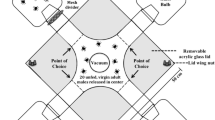Abstract
To determine whether 2,6-dichlorophenol is solely a sex pheromone, the response to it by the various stages of the American dog tick, Dermacentor variabilis, were compared. In contrast to adults, 2,6-dichlorophenol was attractive to unfed nymphs and to unfed larvae. Use of this chemical also prompted the expression of a novel type of ‘feeding’ posture behavior in adults. The overlap in attraction to other substituted phenols plus the lack of functional value of this response for larvae and nymphs rules out the possibility that 2,6-dichlorophenol is a general attractant. However, 2,6-dichlorophenol likely plays a dual role as an attachment stimulant in the adult tick.
Similar content being viewed by others
References
Arlian, L.G. and Vyszenski-Moher, D.L. 1995. Responses of Sarcoptes scabiei va. canis (Acari: Sarcoptidae) to lipids of mammalian skin. J. Med. Entomol. 32: 34–41.
Berger, R.S. 1972. 2,6–Dichlorophenol, sex pheromone of the lone star tick. Science 177: 704–705.
Blum, M.S. 1985. Fundamentals of insect physiology. Wiley, New York.
Hess, E. and De Castro, J.J. 1986. Field tests of the response of female Amblyomma variegatum (Acari: Ixodidae) to the synthetic aggregation-attachment pheromone and its components. Exp. Appl. Acarol. 2: 249–255.
Klompen, J.S.H, Keirans, J.E., Filippova, N.A. and Oliver, J.H. 1996. Idiosomal lyrifissures, setae, and small glands as taxonomic characters and potential indicators of ancestral segmentation patterns in larval Ixodidae (Acari: Ixodida). Int. J. Acarol. 2:113–134.
Norval, R.A.I., Peter, T., Yunker, C.E., Sonenshine, D.E. and Burridge, M.J. 1991a. Responses of the ticks Amblyomma hebraeum and A. variegatum to known or potential components of the aggregation-attachment pheromone. I. Long-range attraction. Exp. Appl. Acarol. 13: 11–18.
Norval, R.A.I., Yunker, C.E., Duncan, I.M. and Peter, T. 1991b. Pheromone/acaricide mixtures in the control of the tick Amblyomma hebraeum: Effects of acaricides on attraction and attachment. Exp. Appl. Acarol. 11: 233–240.
Rechav, Y., Terry, S., Knight, M.M. and Cross, R.H.M. 1977. Chemoreceptor organs used in detection of pheromone(s) of the tick Amblyomma hebraeum Koch (Acarina: Ixodidae). J. Med. Entomol. 14: 395–400.
Schöni, R., Hess, E., Blum, W. and Ramstein, K. 1984. The aggregation-attachement pheromone of the tropical bont tick Amblyomma variegatum Fabricus (Acari, Ixodidae): Isolation, identification and action of its components. J. Insect Physiol. 30: 613–618.
Sokal, R.R. and Rohlf, F.J. 1981. Biometry. W.H. Freeman Press, New York.
Sonenshine, D.E. 1991. Biology of Ticks. Oxford University Press, New York.
Walker, A.R., Lloyd, C.M., McGuire, K., Harrison, S.J. and Hamilton, J.G.C. 1996. Integumental glands of the tick Rhipicephalus appendiculatus (Acari: Ixodidae). J. Med. Entomol. 33: 734–742.
Winston, P.W. and Bates, D.S. 1960. Saturated solutions for the control of humidity in biological research. Ecology 41: 232–237.
Yoder, J.A., Atwood, A.D. and Stevens, B.W. 1998. Attraction to squalene by ticks: First demonstration of a host-derived tick attractant. Internat. J. Acarol. 24: 143–147.
Yunker, C.E., Peter, T., Norval, R.A.I., Sonenshine, D.E., Burridge, M.J. and Butler, J.F. 1992. Olfactory responses of adult Amblyomma hebraeum and A. variegatum (Acari: Ixodidae) to attractant chemicals in laboratory tests. Exp. Appl. Acarol. 13: 295–301.
Author information
Authors and Affiliations
Additional information
Undergraduate Research Program in Biology
Rights and permissions
About this article
Cite this article
Yoder, J.A., Stevens, B.W. Attraction of immature stages of the American dog tick (Dermacentor variabilis) to 2,6-dichlorophenol. Exp Appl Acarol 24, 159–164 (2000). https://doi.org/10.1023/A:1006419203251
Issue Date:
DOI: https://doi.org/10.1023/A:1006419203251




